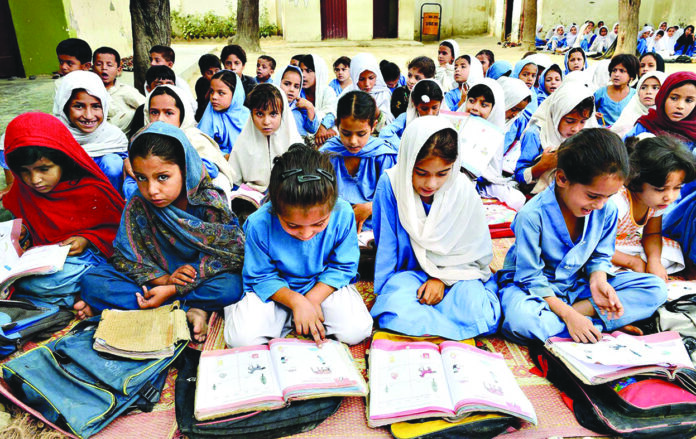Education is a key tool for social and economic development and is widely recognized as a fundamental human right. However, in Pakistan, gender disparity exists to a greater extent, with girls discriminated against across various dimensions: firstly, this disparity exists on enrollment level, some progress has been made in the last two decades, nevertheless, girls’ enrollment rates at primary, secondary, and tertiary levels lag behind those of boys. Cultural norms, financial constraints, and security concerns often dissuade families from sending their daughters to school.
Secondly, the retention and completion of education among girls is another obvious issue. Among girls who enroll in school, dropout rates are higher compared to boys. Many factors are responsible for this low ratio such as early marriage, household responsibilities, lack of access to sanitary facilities, and gender-based violence.
Thirdly, quality of education: girls who do attend school often face subpar learning environments, including overcrowded classrooms, poorly trained teachers, and inadequate facilities. According to a report published by the Islamabad Policy Research Institute,10.5 percent of schools are without proper buildings, 61 percent lack electricity, 42 percent lack toilet facilities. In rural areas, teachers do not prefer to go to school regularly which ultimately impacts the quality of education in public schools. These challenges further undermine the educational outcomes and prospects for girls.
Several interrelated factors contribute to the gender disparity in education in Pakistan. Traditional patriarchal norms in Pakistan dictate that women’s primary role is within the household and to do house chores. This attitude leads to a devaluation of girls’ education compared to boys’. Prevailing attitudes towards gender roles reinforce the general perception that investing in girls’ education is not very productive and investment should only be in boys’ education.
Poverty is the root cause of all the barriers to attaining gender parity in Pakistan. Poverty is a significant barrier to education, particularly for girls. Families facing economic constraints may prioritize sending their male children to school over female children, which perpetuates the cycle of gender disparity. Another valid reason for parents is the concern about the safety and security of girls on their way to and from school, as well as within the school environment itself, which discourages parents from sending their daughters to school, due to rising rape cases in Pakistan and instances of harassment and violence against girls. Sustainable Social Development Organization released the report: up to 6,624 rape cases were registered in 2023, meaning that one woman was raped every 45 minutes. Faisalabad topped the list with 728 cases, followed by Lahore (721) and Sargodha (398).
Limited access to education deprives girls of opportunities for economic empowerment, thus hindering their ability to break the poverty cycle. This not only impacts individual families but also undermines the country’s overall economic development. Pakistan’s gender gap has widened by 0.7 percentage points in just one year. According to the World Economic Forum (WEF), Pakistan ranked 153rd in health and survival, 152nd in economic participation and opportunity, 144th in educational attainment, and 98th in political empowerment indices out of 156 countries.
Educated women are more likely to make informed decisions about their health and the health of their families, leading to improved maternal and child health outcomes. Conversely, lack of education contributes to higher rates of maternal mortality, malnutrition, and preventable diseases. Education is a catalyst for social empowerment, and enables individuals, particularly women, to participate more fully in civic and political life. Excluding girls from educational opportunities can undermine Pakistan’s potential for inclusive and equitable social development.
Education gender disparity in Pakistan is a complex and deeply entrenched issue that requires sustained efforts at the policy, community, and individual levels. By addressing the root causes of disparity, investing in girls’ education, and fostering an enabling environment for gender equality.
Strengthening legal frameworks and policies to promote gender equality in education is needed, including measures to eliminate gender-based discrimination. Implementation of Article 25 of constitution of Pakistan in true spirit must be done that says “There should be no discrimination on the basis of sex alone”.
Ensure equal access to education, and address barriers to girls’ retention and completion of education. Pakistan is a signatory of the UN Convention on the Elimination of all forms of discrimination against women that binds the government to take all forms of measures to eliminate discrimination against women in all walks of life. By Improving school infrastructure, including the construction of safe and accessible school buildings, provision of clean water and sanitation facilities, and enhancement of transportation networks to ensure safe access to schools. Community Engagement is also very crucial to challenge the traditional gender norms. To Work closely with communities, religious leaders, and local stakeholders to raise awareness about the importance of girls’ education, and promote positive attitudes towards gender equality. Lastly, taking initiatives like girls’ Empowerment Programmes to implement targeted interventions, such as girls’ mentoring programmes, scholarships, and vocational training initiatives, to encourage girls and provide them with the skills and support they need to pursue and complete their education.
Education gender disparity in Pakistan is a complex and deeply entrenched issue that requires sustained efforts at the policy, community, and individual levels. By addressing the root causes of disparity, investing in girls’ education, and fostering an enabling environment for gender equality. It is imperative that all stakeholders, including government agencies, civil society organizations, and international partners, work together to bridge the gender gap in education and ensure that every child, regardless of gender, has the opportunity to fulfill their educational aspirations and contribute to society.






















